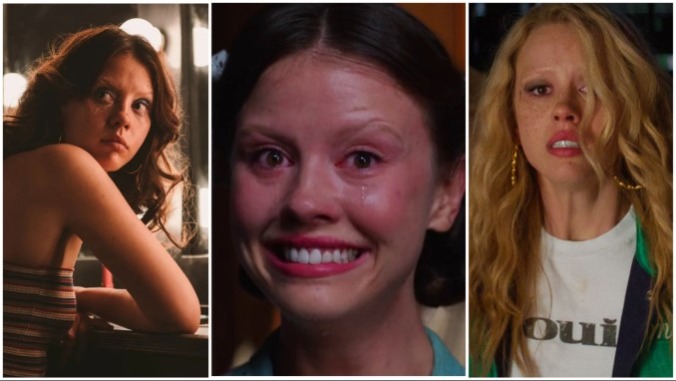Triple Threat: In His Subgenre-Spanning X Trilogy, Ti West Made Mia Goth a Superstar

A story has a beginning, a middle, and an end. Maybe that’s why the trilogy is such a satisfying structure for so many epic series or curious corners of cinema history. This year in Triple Threat, Ken Lowe revisits another of cinema’s best trilogies each month, including some unofficial trilogies that have come to define a director, actor, or time in film history. You can follow the series here.
Horror movies tend to be either standalone entries or franchises that are deathless in every sense of the word: Perennially renewed, their big bads not subject to the petty limitations of mortality. Trilogies in the genre, whether official or unofficial, are therefore pretty special (one of the reasons this makes arguably the fifth one I’ve covered this year, depending on if you count the unofficial ones). Very few horror movie series—very few trilogies at all, when you get down to it—are meticulously planned from the beginning to be trilogies. Hollywood might work that way for big, established franchises that are going to sell a bunch of Happy Meals, but most of the time, any sequels are contingent on the success of the original. That is normally how this stuff is supposed to work.
Being as writer-director Ti West was planning his film X during the initial isolation of COVID-19, stuff was not normal. Isolated, eager to film, and gifted with being in a country with rock-bottom COVID infections at the time (New Zealand) and plenty of available crew, he decided to do something bold, shooting a sequel to X in secret as soon as filming on the first film wrapped. As West said in an interview in 2022, “You can’t make a slasher movie without a bunch of sequels.” In this case, studio A24 fortunately thought it was a good idea.
Mia Goth (who co-wrote the prequel/sequel Pearl with West and plays dual roles in X) was already working her way up to a notable career, starring in Lars von Trier’s Nymphomaniac Vol. II and in the creepiest of the three short films that comprise Netflix’s The House. In Ti West’s trilogy, though, any doubts about her ability to carry a film on her own have been laid to rest (in a gator-infested swamp).
The Movies
It’s 1979 and Maxine (Goth) and a vanload of other low-budget filmmakers have a simple plan: Renting a remote guest house on a rural farmstead that they’ll use to shoot a pastoral, pornographic movie. Maxine wants one thing and one thing only, which is to be a star at any cost, even if it’s in the porn industry rather than Hollywood proper. For that, she’s yoked herself to streetwise and sleazy producer Wayne (Martin Henderson) and his cast and crew, who are all a different flavor of idealistic or cynical: On-camera stars Bobby-Lynne (Brittany Snow) and Jackson (Kid Cudi himself), aspiring auteur cinematographer RJ (Owen Campbell), and his deeply conflicted boom mic operator girlfriend Lorraine (Jenna Ortega). When the crew arrives at the secluded farmstead, they discover a hostile, borderline senile owner, Howard (Stephen Ure), and his aged wife Pearl (Goth again, nearly unrecognizable in a total makeup and prosthetic transformation).
Ti West has acknowledged the homage to The Texas Chain Saw Massacre in his film, and it’s obvious in everything from the lead-up to the murder to its nubile-young-kids-vs.-creepy-backwoods-folk premise. What’s interesting, as the film slowly builds up to the bloodbath you just know is coming, is how West puts the tensions of the time period on display—Kid Cudi’s proud porn star is also a Vietnam vet and keen to remind Howard of this. The group of porn stars sit around the cabin and talk sexual liberation with Ortega’s reluctant Lorraine—and when she impulsively decides to bare all, it’s seemingly to make a point to her boyfriend.
Slasher films have always, always had an undercurrent of resentment toward the young and sexually active teens who are so frequently the victims. Films like Behind the Mask: The Rise of Leslie Vernon and The Cabin the Woods are a subgenre of metacommentary on this most crypto-conservative of horror genres. West’s approach strips all subtext away, and thank God: Pearl and Howard are killing these kids because they are old, horny, and struggling with their own age and inevitable sexual decline, and they hate to see other people happy. It’s not just stunt casting to put Goth in the dual role of the Final Girl and the arthritic slasher, because, as we see before the final curtain, both characters are defined by their covetousness, the survivor destined to inevitably become the monster.
It was also shorter than two hours! The script was great! They should make more of these.
I feel like we need to remind ourselves of this: Prequels almost universally and uniformly suck. They’re usually unnecessary; they often cheapen or mishandle the characters we already know, or make literal things that are best left figurative or to our imaginations. There’s a reason Kurt Vonnegut advised writers to start a story as close to the conclusion as possible, and prequels remind us of this.
-

-

-

-

-

-

-

-

-

-

-

-

-

-

-

-

-

-

-

-

-

-

-

-

-

-

-

-

-

-

-

-

-

-

-

-

-

-

-

-








































